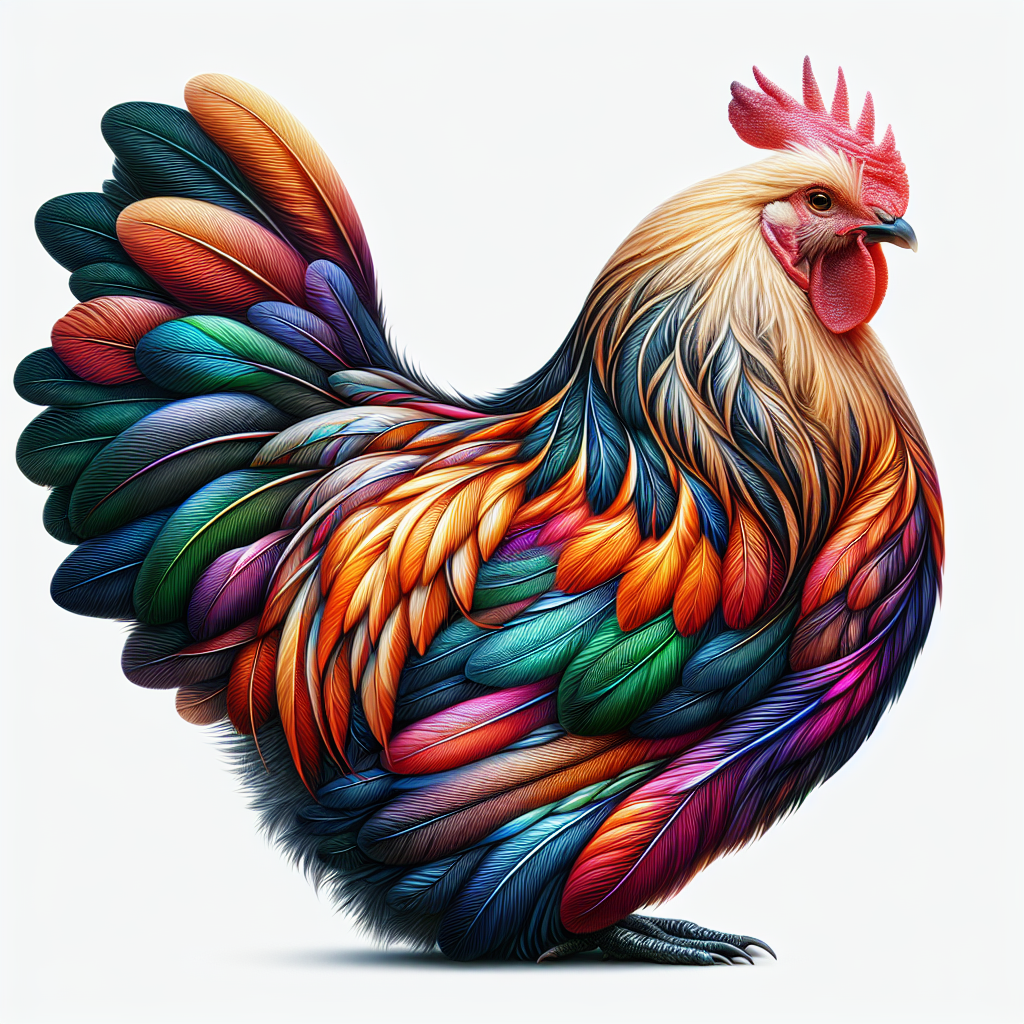Have you ever wondered how hybrid chickens stand out from other breeds? Understanding the physical characteristics of hybrid chickens is key to recognizing their unique traits. From their feather color and body shape to their size and temperament, hybrid chickens possess distinctive features that set them apart from other breeds. In this article, we will explore the fascinating world of hybrid chickens and delve into the ways in which their physical characteristics differ from those of other breeds. So, let’s embark on this exciting journey and uncover the secrets of these extraordinary creatures!
Hybrid Chickens vs Other Breeds
General Overview
When it comes to selecting the right breed of chicken for your backyard flock, it’s essential to understand the physical characteristics and traits that differentiate hybrid chickens from other breeds. Hybrid chickens, also known as crossbred chickens, are the result of crossing two or more purebred chicken breeds. These crosses are carefully designed to combine the desirable traits of each parent breed, resulting in chickens that possess a unique combination of characteristics.
Physical Features
One of the significant ways hybrid chickens differ from other breeds is in their physical features. While purebred chickens often have distinct breed-specific features, hybrids may exhibit a variety of traits influenced by their parent breeds. This diversity in physical characteristics is one of the reasons why hybrid chickens are preferred by many backyard chicken enthusiasts.
Growth Rate
One notable characteristic that sets hybrid chickens apart from other breeds is their impressive growth rate. Due to their crossbred genetics, hybrid chickens tend to reach maturity faster than their purebred counterparts. This faster growth rate means that hybrid chickens can be ready for butchering or laying eggs in a relatively short period. If you’re looking to raise chickens for meat production or want a quick start to egg production, hybrid chickens are an excellent choice.
Feathers
Plumage Color
Feather color can vary widely among hybrid chickens and other breeds. While some purebred chickens are known for their specific plumage color, hybrids can exhibit an array of color combinations. From vibrant reds and oranges to a striking combination of black and white, the plumage color of hybrid chickens can be a delightful and diverse addition to any backyard flock.
Feather Patterns
Along with a range of colors, hybrid chickens can also display various feather patterns. These patterns can range from simple and uniform to intricate and eye-catching designs. Some hybrids may have laced feathers, where the edges of each feather are outlined with a contrasting color, creating a beautiful pattern. Others may have mottled or speckled feathers, adding a unique aesthetic appeal to your chicken coop.
Body Size
Average Weight
Compared to purebred chickens, hybrid chickens often have a larger body size. The combination of different parent breeds contributes to this increased average weight. While the size can vary depending on the specific cross, the overall result is a chicken that can provide more meat if raised for meat production purposes.
Breed Comparison
When comparing hybrid chickens to other breeds, it’s essential to note that purebred chickens can have varying sizes. Some purebred breeds, such as the Jersey Giant or Brahma, can rival the size of hybrids. However, on average, hybrid chickens tend to have a larger body size compared to most individual purebred breeds.
Body Shape
Head Shape
The shape of a chicken’s head is influenced by its parent breeds. Hybrid chickens often have a more rounded or intermediate-shaped head rather than the more pronounced features of some purebred breeds. This characteristics adds a unique charm to hybrids and can make them easily recognizable among other chickens.
Neck Length
The length of a hybrid chicken’s neck can vary depending on the combination of parent breeds. Some hybrids may have elongated necks, while others may have necks of a more proportional length. Regardless of the exact neck length, hybrid chickens generally showcase a graceful posture that contributes to their overall appeal.
Chest and Body Structure
Hybrid chickens typically have a well-developed chest and body structure. The combination of different parent breeds allows hybrids to have a balanced physique, with a sturdy frame that enables them to be active and productive. This robust body structure contributes to their overall health and productivity.
Legs and Feet
Leg Proportions
The proportions of hybrid chickens’ legs can vary depending on the breeds involved in the cross. Some hybrids may have relatively longer legs, while others may have shorter legs. These leg proportions are influenced by the parent breeds and can affect the overall appearance and agility of the hybrid chickens.
Toes and Spur Length
Hybrid chickens usually have the same number of toes as other breeds, typically four on each foot. The length of their spurs, which are bony growths on the back of the legs, can also vary. While spurs are more commonly found in roosters, some hybrids may possess shorter or smaller spurs compared to certain purebred breeds.
Egg Laying Characteristics
Egg Size
When it comes to egg laying, hybrid chickens are known for producing eggs of varying sizes. The typical size of the eggs laid by hybrids can range from medium to large, depending on the parent breeds. If you’re looking to satisfy your breakfast needs with a diverse range of egg sizes, hybrid chickens are an excellent choice.
Egg Color
One of the exciting aspects of hybrid chickens is the range of egg colors they can produce. From the classic white and brown eggs to exquisite shades of blue, green, or even pink, hybrid chickens can bring a delightful variety to your egg basket. The specific egg color of a hybrid chicken is determined by the genetics inherited from their parent breeds.
Laying Rate
Hybrid chickens are renowned for their impressive egg laying rate. The carefully designed crosses of parent breeds often result in hybrids that exhibit excellent laying capabilities. While the exact laying rate can vary depending on the specific hybrid and individual factors, it’s not uncommon for hybrid chickens to provide a steady supply of eggs throughout the year.
Behavior
Aggressiveness
When it comes to assessing the behavior of hybrid chickens, they generally exhibit a friendly and docile temperament. Aggressiveness can be rare among hybrids, as the parent breeds selected for the cross often have calm and gentle characteristics. This friendly behavior makes hybrid chickens a great choice for families and individuals looking to enjoy the company of their feathered friends.
Foraging Ability
Hybrid chickens typically have a robust foraging ability, allowing them to search for and find food efficiently. Their natural instinct to scratch and peck enables them to explore the surroundings, which is not only a source of entertainment for them but also helps with pest control in your backyard. This foraging ability is an inherent trait inherited from their parent breeds.
Climate Adaptability
Cold Weather
Hybrid chickens, like many other chicken breeds, exhibit a considerable degree of adaptability to cold weather conditions. While they may require some additional protection during extreme cold spells, hybrid chickens generally have suitable feathering and insulation to withstand chilly temperatures. Providing adequate shelter and protection from drafts can help ensure their comfort during colder months.
Hot Weather
Hybrid chickens are also well-adapted to hot weather conditions. Generally, they handle heat well due to their ability to regulate body temperature efficiently. However, it’s important to provide access to shade, fresh water, and proper ventilation during hot summer days to prevent heat stress. Keeping your hybrid chickens cool and comfortable will contribute to their overall health and well-being.
Health and Disease Resistance
Common Health Issues
Hybrid chickens are generally known to have good health and disease resistance. The blending of different parent breeds often results in a phenomenon known as hybrid vigor, which enhances their overall robustness and ability to resist various diseases. However, like any other chicken breed, hybrids are not entirely immune to common poultry health issues such as respiratory infections or parasitic infestations. Regular health monitoring, proper nutrition, and a clean living environment are essential to ensure the well-being of your hybrid flock.
Hybrid Vigor
Hybrid vigor, also known as heterosis, is a phenomenon observed in hybrid chickens. It refers to the increased health, growth rate, and productivity seen in hybrids compared to their purebred parents. This vigor is a result of favorable gene combinations from the parent breeds, resulting in hybrid chickens that often outperform their purebred counterparts in terms of overall health and productivity.
Breeding and Reproduction
Mating Behavior
Hybrid chickens, like other breeds, exhibit natural mating behaviors. In a mixed flock, hybrids may mate with other hybrids or purebred chickens, producing a diverse range of offspring. The specific mating behaviors of hybrid chickens are influenced by their parent breeds, and observing these behaviors can be a fascinating aspect of raising these crossbred chickens.
Fertility
Fertility can vary among hybrid chickens, depending on the specific cross and individual factors. In general, hybrid chickens are fertile and capable of producing offspring. However, some hybrids may exhibit reduced fertility compared to their purebred parents. If breeding hybrid chickens is of interest to you, it’s essential to carefully consider the parent breeds and seek advice from experienced breeders to ensure successful reproduction.
In conclusion, hybrid chickens possess a unique combination of physical characteristics that distinguish them from other breeds. From their diverse feather colors and patterns to their impressive growth rate and adaptability, hybrid chickens offer a blend of desirable traits inherited from their parent breeds. Whether you’re looking for a productive egg-laying flock or a meaty addition to your dinner table, hybrid chickens can be a valuable and delightful choice for any backyard enthusiast.




